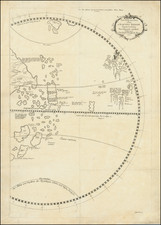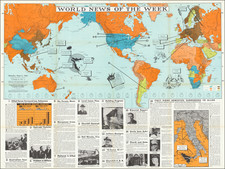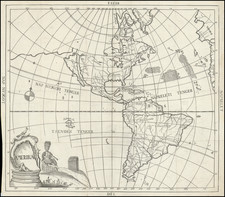A Medieval Mappamundi, One of the First Printed World Maps
Rare and intriguing medieval world map from Le mer des hystoires, the monumental encyclopedia of world history first published in 1475. This example, from the 1491 Lyon blocks, is one of the first printed world maps.
The map is arrayed in a disc with east oriented at the top. While it does carry some similarities to T-O style maps, it does not have an encompassing world ocean. Jerusalem, shown by a formidable castle, is near the center. The Pope is nearby, in Rome, while other figures—rulers, a scholar, and, curiously, a faun—are tucked amongst the rolling hills. There are also dragons, deer, and a raven. Each of these hills are labeled with a settlement or polity, including India, Persia, and Libya. The Pillars of Hercules guard the entrance to the Atlantic Ocean, at the bottom of the map.
At the top, in the east, is a high-walled castle. Rivers spill from it, filling the rest of the world. Inside are two figures. While one might expect them to be Adam and Eve, closer inspection shows them to be two men, a scholar and a monk. Their precise identification and relationship is a matter of scholarly debate, but they are thought to the representations of the Master and his Novice, as the book is an instructional compendium for students.
T-O maps
T-O maps were medieval world maps that show a diagrammatic understanding of the known world. The T refers to the placement of the three continents as separated by bodies of water. East-oriented, Asia is shown as the top, with Europe and Africa below. They are bifurcated by the Nile (and sometimes the Don, or Tainus) and the Mediterranean Sea. Surrounding all is an O of a world ocean.
The idea of a world ocean surrounding the known world antedates Christianity, but by the medieval period this sort of map had taken on Christian features. Jerusalem was often placed at the center of the map and many of the surviving manuscript examples include Christian imagery, such as that on the Hereford mappamundi. The east-orientation is associated with the Garden of Eden, which is supposedly in the direction of the rising sun. The three continents were thought to have been populated by descendants of the three sons of Noah.
The best early explanation for the T-O diagrammatic map is included in the work of the seventh-century savant, Isidore of Seville. His Etymologiae describes the tripartite world. In Augsburg in 1472, the Etymologiae was printed with a T-O diagram included and this is widely considered the first printed map.
Rudimentum Novitorum and Le Mer des Hystoires
If Isidore’s diagram is the earliest printed map, the earliest printed map to depict countries and geographic features in topographical relation to each other was printed in 1475 in Lübeck in the Rudimentum novitiorum. An illustrated history of the world, the work was published by Lucas Brandis as a teaching aid for monks.
The work contained two maps, one of the Holy Land and this one of the world. As seen here, the world map is a Christianized T-O adaptation with additional information; it does not reference Ptolemaic or portolan sources.
The Lübeck blocks were only used for the 1475 edition. The most famous iteration of the Rudimentum novitiorum, however, is the French translation, titled Le mer des hystoires and published in Paris in 1488 by Pierre Le Rouge. This edition used new blocks which were slightly smaller, but they nevertheless closely adhered to the Lübeck predecessors. Small corrections include the separation of Trabobata (Sri Lanka) from Trabobana (Java). Amazonica has become Le royaume des femmes.
New blocks were made again for a printing in Lyon in 1491 by Jean Dupré. The version printed in Lyon is clearer and includes several corrections to the earlier works. Tony Campbell suggests that the 1488 edition maps remained close copies of the 1475, but that the 1491 blocks show original thought and innovation. These Lyon blocks were used for a second Lyons edition in 1506, as well as to illustrate Paris editions in ca. 1517, 1536, 1543-4, ca. 1550, and ca. 1555.









![[World] Air France](https://storage.googleapis.com/raremaps/img/small/67997.jpg)
![Ленин – вождь международного пролетариата [Lenin – Leader of the International Proletariat]](https://storage.googleapis.com/raremaps/img/small/93242.jpg)

![P. Mc.D. Collins' Proposed Overland Telegraph Via Behring's Strait and Asiatic Russia to Europe, Under Russian & British Grants. . . 1864 [accompanied by separate text:] Communication of Hon. William H. Seward, Secretary of State, upon the subject of an Intercontinental Telegraph connecting the Eastern and Western Hemispheres by way of Behring's Strait, In Reply to Hon Z. Chandler, Chairman of The Committee on Commerce of the U.S. Senate, To Which Was Referred The Memorial of Perry McDonough Collins.](https://storage.googleapis.com/raremaps/img/small/87461.jpg)

